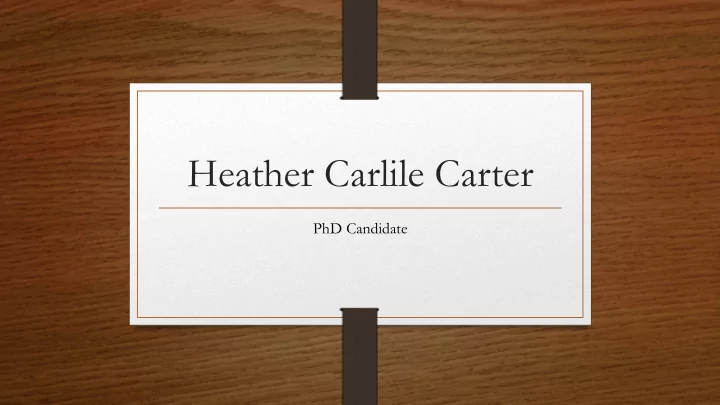

Heather Carlile Carter PhD Candidate
Storied objects: Older adult placemaking through meaningful possessions Dissertation Research
“….the proper plight of dwelling does not lie merely in lack of houses…The proper dwelling plight lies in this, that mortals ever search anew for the essence of dwelling, that they must ever learn to dwell.” Martin Heidegger (1971, p. 363), a 20th-century philosopher, wrote this after WW2
Conceptual Framework • Life course perspective (Ferraro & Wilmoth, 2013) • Meaningful Possessions and the Extended Self (R. W . Belk, 1988; Csikszentmihalyi & Rochberg-Halton, 1981) • Placemaking (Low & Altman, 1992; Rubinstein & Parmalee, 1992) • Household Disbandment (Ekerdt, 2004)
Conceptual framework - models • Home and Homelessness • The Experience of Relocation: Remaking Home Model • Generalized Extent of Home Range
Home and homelessness as a continuum (Watkins & Hosier, 2005) Personal changes as well as environmental changes continually influence what imagined home entails.
The Experience of Relocation: Remaking Home Model (G. D. Rowles, 2013) Relocations experienced over the life course contribute to the way end of life relocations are experienced.
Generalized extent of home range (Rapoport, 2005) Our home range begins in a crib & expands over the life course, reaching maximum range around middle age. During old age the home range shrinks to, finally, the bed upon which we die.
Research questions • What characteristics are associated with the possessions older adults move with them into senior apartments? • How do older adults use these possessions to contribute to placemaking after household disbandment?
Methods Grounded theory Interviews, Approximately 15 with a sensitivity to observations, & participants narrative inquiry photo-elicitation Consider life stories Retirees 65 or older Initial meeting for consent and camera Coding interactions Downsized in last 3 in past, present, & years due to actual 60-90 minute future or anticipated health interviews issues Coding initial, focus, & categories
Purposeful selection of sites & participants • Flyer • Social media (Facebook.com) • Word of mouth • New senior living facilities
Data collection so far… • 3 couples • 4 individuals • Oliver – 75, Nina – 81 • Cole – 94 • Bernard – 70, Abbie – • Donna – 81 69 • Elaine – 93 • Lance, Monica – 87 • Fern – 90
Emerging focus codes What characteristics are associated with the possessions older adults move with them into senior apartments?
Abbie, “ There is a funny story behind the grapes. I saw them when I went to pick out flowers for my wedding. I said, ‘I like those grapes.’ Mom said, ‘You really do?’ I said, ‘Yeah, they’re cool.’ So my brother, Jack, who was 14, bought them for our wedding. It almost makes me cry now to talk about it. The compote [dish] is from Grandma, so my grandmother and Jack. Embedded Family
Embedded Meaning “Even though I started thinking, ‘Those look a little tacky,’ I wouldn’t get rid of them because they have meaning…. Grandma Jones and my brother, Jack – they’re two of my favorite people. Grandma came to live with me when I was 18 months old, and she still lived with my family when we got married. Jack & I have the most in common. He loved poetry, he loved crossword puzzles, a lot of the same things I loved.”
Cole, “Tools are the most important – to build stuff and keep stuff repaired.” Son, “We brought tools when he came. When we got here, he kept asking for more tools, & even today there was a note saying, ‘Take me to buy a hammer. I want to pick it out.’ He doesn’t like my hammer. He’s working on Embedded Work tiles in the bathroom.”
Embedded Meaning “I never saw my father. He was always on the road. This was during the depression….He didn’t have a job all that time.” “I was a sorry boy….it was rough.” “They were hiring at a dry goods store, & sure enough he got on, & boy, that saved his life. It save our life.”
Chair as command-central • They are comfortable & ergonomic. • They are generally positioned within a path of travel. • There may be a major chair and a sub-chair. • Important objects are gathered around the chair (lamp, table, remotes, books, phone, reading glasses). • Chair has visual connectivity to memory shrine.
Memory shrines visually display multiple prized possessions together • Encouraging self • Remembering past events • Remembering loved ones • Continuing participation in life
Visual relationships between command-central chairs & memory shrines How do older adults use these possessions to contribute to placemaking after household disbandment?
Chair is directly across from closet: door is kept open to display planes he flew, toolbox is on the floor, and toy train buildings are on the bookshelf.
Chair is directly across from desk with calendar of activities, family portraits, & clock from alma mater
Chair is next to mantel with inspirational words, the Serenity Prayer, and son’s metal work
Chairs are positioned in front of the shrine of family & friends photographs and a 50 th wedding anniversary quilt and next to a family heirloom desk.
Findings • Older adults often position themselves in their new places so that they can see objects of the past and present. • Embedded meaning in precious possessions include family and work.
“ The proper dwelling plight lies in this, that mortals ever search anew for the essence of dwelling, that they must ever learn to dwell. ” My hope is that if we can deepen our understanding and respect of how the frail elderly use their precious possessions in the process of “every learning to dwell,” then perhaps we can help care for them in their late life transitions. In summary
Continuing research • Interviewing additional participants until data saturation • Analyzing the visual relationships between shrines and command-central chairs • Working on a framework that represents the way objects embed the participants’ life stories.
Thank you. Questions?
Recommend
More recommend